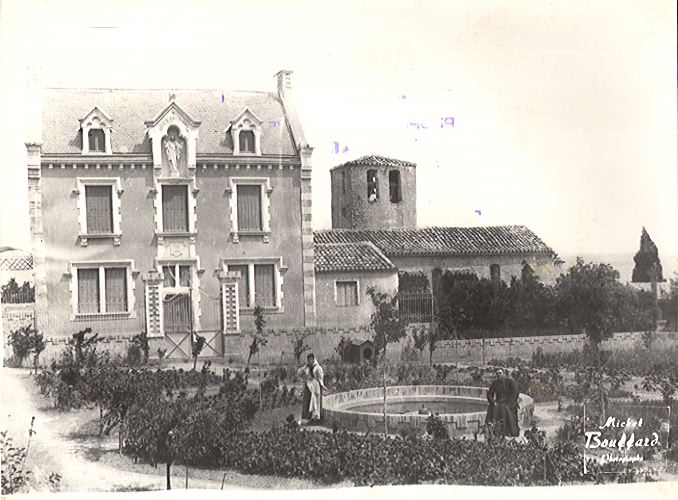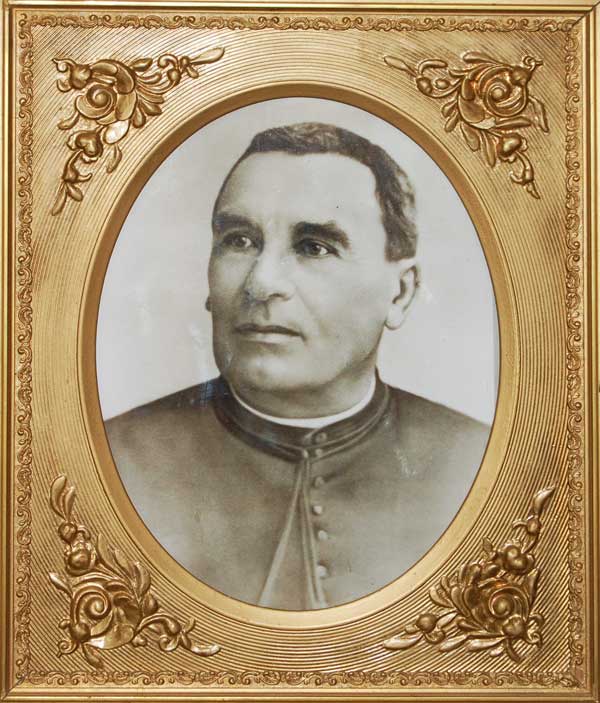 Abbé François Bérenger Saunière (1852-1917)
Abbé François Bérenger Saunière (1852-1917)
François Bérenger Saunière was born on 11th April 1852 in Montazels, a small village not far from Rennes-le-Château in the department of the Aude in the South of France. The house of his birth is still there today on the village square (La Place) behind an 18th century dolphin fountain. He was the eldest of the 7 children of Marguerite Hugues and Joseph Saunière. He had two brothers (Alfred, Martial and Joseph jr.) and three sisters (Mathilde, Adeline, and Marie-Louise). His father Joseph, nicknamed le Cubié, was a busy man at the same time being a grocer, Mayor of Montazels, manager of the local flour mill and steward to the Marquis de Cazemajou. Joseph was a quick-tempered man and his marriage to Marguerite wasn’t always a happy one.
Bérenger was a healthy and athletic child of the country and spent much time playing in the fields and mountains of the region. He went to the school of St. Louis in Limoux. Being the eldest son almost automatically meant that young Bérenger was destined for a career in the clergy. So in 1870, at the age of 18 he entered the Grand Seminary of the city of Narbonne. His brother Alfred would follow in his footsteps some time later. Bérenger was ordained priest in july of 1879. After having served as a curate in Alet-les-Bains for three years, he became the parish priest (Abbé) in the humble village of Le Clat in June 1882. Le Clat was situated on the lands of the De Negre d’Ables family that would come to play a big part in his later life. After two months he was asked by his old professor in Narbonne to become a teacher at the Seminary of Narbonne. It was there that he got a reputation for being a headstrong insolent man. On June 1st 1885 it resulted in him being assigned to the tiny and utterly unimportant parish of Rennes-le-Château, a community of not more than 300 souls. He was to succeed Abbé Croc, who had died after just a year of service. In his journal the new priest wrote: ‘La croix du milieu existe, mais il n’y a pas d’allées’. He was 33 years old and effectively exiled.
The first suspension
It took Saunière only three months to attract the attention of his superiors again by making a fierce anti-Republican speech on the eve of the 1885 French elections. He urged his parishioners to vote for the ‘Union of the Right’, dedicated to the reversal of the anticlerical legislations of the Republican Government and towards the restoration of the French
Monarchy. When three more priests in the region did the same, René Goblet, the French minister for Religion wrote a letter to Bishop Billard of Carcassonne on 30th October, complaining about the ‘reprehensible behaviour‘ of four clerics during the electoral period of 1885 and asking for their transfers. Billard took up for his priests and made specific reference to Saunière in his reply to the minister: stating that he had had no intention of attacking the Government, but had the right as the Defender of Religion to read an article from the clerical magazine ‘La Semaine Religieuse de Carcassonne’, to give advice to the voters of his parish in the presence of anti-Christian anti-Concordat programmes of several candidates of the deputation. Goblet apparently didn’t like that answer very much which resulted in the suspension of the four priests involved. (B. Saunière, curate at Rennes-le-Château; Tailhan, curate at Roullens; Jean, curate at Bourriège and Delmas, vicar at Alet-les-Bains ). Early December ‘La Semaine Religieuse de Carcassonne’ strongly criticised the suspension of the four priests by the Minister of Religion, mentioning: ‘To the long list of priests who became victim of a systematic persecution since the last electoral period, are to be added the names of four priests of the diocese: Jean – Tailhan – Delmas- Saunière. M. the Prefect of the Aude has notified them a Ministerial decision that suppresses their salary, from 1st December 1885. Their Bishop opposed in vain a firm and dignified justification to the accusations carried against them; there was sorrow to see that M. the Minister of Religion didn’t take any account of it. The blabbers triumphed. Can they understand the gravity of their fault, seeing the consequences in their respective dioceses of their malevolent denouncement…?‘
Rennes-le-Château
The suspension meant returning to Narbonne to teach at the Seminary. The villagers of Rennes-le-Château were unhappy with the decision. In the short time they had known Saunière they had grown to like him. Surviving accounts describe him as a tall, broad shouldered and goodlooking man that they affectionately called ‘le bel homme’. The Municipal Council urged the prefect to let the priest return. This request was eventually satisfied in July 1886 when he was re-instated by Bishop Billard. The priest would entertain excellent relations with Billard until the bishop’s death in 1901. By then Billard himself was a man in the middle of much controversy, perhaps the same one, Saunière would find himself into.
The priest must have had mixed feelings. to once again follow the long dirt road up the mountain back to the tiny village, far away from everywhere else. The village wasn’t a shadow of the important place it once held in the area of the Razès as it was called in earlier days. The history of Rennes-le-Château or Rhedae goes back all the way to prehistoric times and is drenched in the blood and legends of Romans, Visigoths, Knights Templar, Cathars and the Inquisition. The small village 

François Marquis de Chefdebien who is believed to have been Saunière’s intermediary to the Comtesse de Chambord
Saunière wasn’t completely empty handed though. During his time in Narbonne he must have attracted the attention of some important people because on his return he had brought 1.000 francs that had been given to him by the Comtesse de Chambord. She was the widow of Henry V, the last French throne pretender of the Bourbon family. It is thought he received the money by intervention of his brother Alfred who, being a Jesuit priest, was teacher to the important Chefdebien family enabling him to move in the better circles. The money was intended for restoration of the village church of Rennes-le-Château.
The village church, the église Sainte Marie-Madeleine, or Church of Saint Mary-Magdalene probably dates from the 8th or 9th century. It was destroyed and rebuilt several times in its history. In 1209 the city of Rhedae was completely levelled by the crusader army of Simon the Montfort in what has become known as the Albigensean crusade. He gave all that was left of it to on of his Lieutenants, Pierre de Voisins who moved into the local Château and founded a dynasty there. In 1380 the church that had now become the private chapel of the Château was dedicated to Mary Magdalene for reasons we don’t know. Already in 1853, mr Cals, a local architect had concluded that it would be a better idea to re-build the village church from scratch rather than to try and restore it. In 1422 the bloodline of the Voisins ended and their possessions went over to Pierre-Raymond d’Hautpoul when he married Blanche de Marquefave. The powerful and rich Hautpoul family had the church completely restored in 1646, supported by Monseigneur Nicolas Pavillon, bishop of Alet. It is assumed that from that time onwards, the noblemen of the region were buried in the crypt beneath the church.
With the money from the Comtesse and a small loan from the village council, Saunière had enough money to restore the church. He started straight after he had returned. There were urgent repairs to be done on the badly leaking roof and the open windows. In 1887 he installed a new altar and stained-glass windows that he ordered from 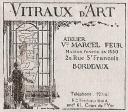
Somewhere between July 1887 and 1890, Antoine Captier, the bellringer of the church, just when he wanted to close the church and go home, noticed a small glass vial, sticking out of the Wooden Baluster that supported the old pulpit. It had been taken down to be removed. He gave it to the priest, who allegedly discovered some parchments in it that either held a secret or led to parchments with a secret. The accounts don’t agree. The only thing that is beyond doubt here is that in Antoine Captier’s family it is told that Abbé Saunière found a treasure and that it all started with this finding.
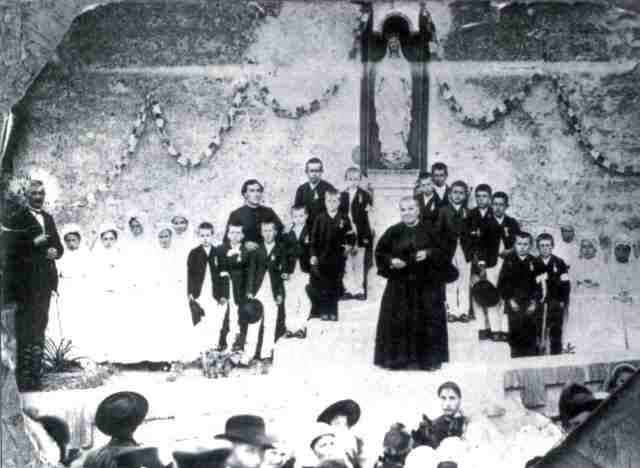 Soon after this, Saunière requested permission from the village council to refurbish the public square in front of his church. As one of the first things he had a stone wall and fence with lock installed. In June 1891, the gardens in the square were finished and inaugurated by Bishop Billard and 24 children of the village celebrating First Communion. A statue of the Virgin of Lourdes was carried around the village in a Tour de Mission. At the end the statue was erected on top of the pillar of the old altar, be it upside down and inscribed Mission 1891, Pénitence! Pénitence!.
Soon after this, Saunière requested permission from the village council to refurbish the public square in front of his church. As one of the first things he had a stone wall and fence with lock installed. In June 1891, the gardens in the square were finished and inaugurated by Bishop Billard and 24 children of the village celebrating First Communion. A statue of the Virgin of Lourdes was carried around the village in a Tour de Mission. At the end the statue was erected on top of the pillar of the old altar, be it upside down and inscribed Mission 1891, Pénitence! Pénitence!.
In September 1891, Saunière wrote in his journal: découverte d’un tombeau, le soir pluie (discovery of a tomb, rain in the evening). One day later, during the work in the church a pot was found containing golden coins. Saunière told the workmen that it was just some worthless Lourdes Medals but locked the church, and sent the workmen home. Straight after the priest travelled to Carcassonne and visited some confrères (colleague priests), four of which returned the visit in Rennes-le-Château on 6th October. Work on the church remained suspended until October 14th, when we read in his journal that new(!) masons have started, indicating he replaced the crew that was present at the discovery.
From this moment onwards, Saunière’s spending started to increase considerably. At the same time he was seen digging in the graveyard with his maid Marie Dénarnaud at night to such extent that the villagers filed a complaint with the community council. Witnesses say he appeared to dig holes randomly, some as deep as three metres. It would take until March 1895 until Saunière was officially summoned by the authorities to end his nightly adventures in the cemetery.
Witnesses have testified that Saunière offered antique jewellery to Marie Dénarnaud which would imply that perhaps by his digging, the priest had forced access into the old crypt beneath the church and was pillaging the Tombs of the Lords there.
According to Gérard de Sède, but impossible to confirm, in 1892 Saunière travelled to Paris to have his parchments decoded by Emile Hoffet, the young nephew of Abbé Bieil who then led Saint Sulpice. He allegedly returned armed with three copies of paintings from the Louvre: The Shepherds of Arcadia by Nicolas Poussin, the Temptation of St. Anthony by Teniers and a portrait of Pope Celestine V from an unknown painter. This story is unlikely as the Louvre didn’t sell reproductions at the time and no records have been found of any Saunière visit to the Seminary of Saint Sulpice.
What is certain is that Saunière undertook a number of trips for longer periods of time around that time. Oddly, he left a supply of notes with is maid, stating since I am in a hurry to leave for visiting one of my confrères, for now I will just inform you I have received your letter and thank you for your message.. All Marie had to do was put a date on them and send them to the writer of any letter that arrived. This way it would appear the priest had been present at the time it was received. Saunière actively hid his absence from his parish. Clearly, he didn’t want anyone to know where he was and for how long.
In 1894 Saunière installed an iron gate, blocking access to the cemetery. With his study and library being installed next to it, he now had complete control over who visited there. The behavior of the priest was becoming more peculiar. On 14th July 1895, the Abbé refused access to the pump and well beneath his study to the villagers that wanted to use it to fight a fire in a nearby house. There are stories that the priest had hidden bags below his study with whatever he had brought back from his journeys.
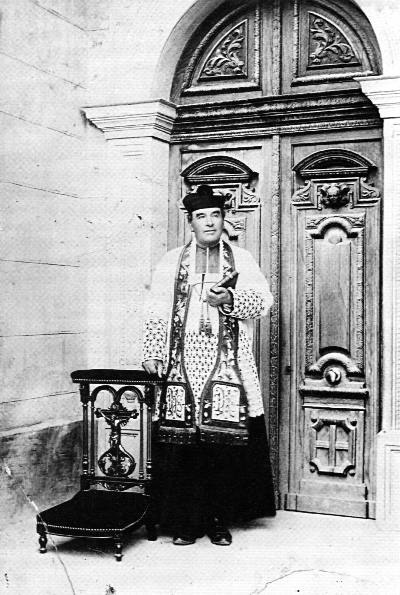 In the following years, the restoration of the village church was finished to its current state. It was officially inaugurated by Bishop Billard on 6 July 1897. Some months later, Antoine Gélis, priest of the neighboring village of Coustaussa was murdered in a most violent way.
In the following years, the restoration of the village church was finished to its current state. It was officially inaugurated by Bishop Billard on 6 July 1897. Some months later, Antoine Gélis, priest of the neighboring village of Coustaussa was murdered in a most violent way.
In 1898 Saunière visited Lyon where he rented a house and visited a Martinist gathering. Saunière was leading an a-typical life for a priest. When Bishop Billard nominated him for the function of ‘Personnat’, the diocese refused after an investigation into the priest’s life. In Saunière’s journal we read that the 50 liters of rum he ordered from Jamaica are late.
In May 1901, Saunière owned pretty much all of the hilltop in Rennes-le-Château. On these lands that he had bought in name of Marie he started the construction of a luxurious villa. He claimed this Villa Bethania was destined to become a retirement home for old priests. At the end of that year, Bishop Billard suddenly died to be replaced by Bishop de Beauséjour. The death of Billard is shrouded in scandal. He died while being under investigation for having administered the assets of his diocese in the most irregular fashion and for having contracted staggering debts, which were completely unjustified.
The construction work continued steadily even though the priest had some trouble to pay his bills around August 1903. That didn’t stop him from starting yet another project. On a corner of his terrain, he had a neo-gothic tower erected. After first calling it Tour du Midi and Tour de l’Horloge, he eventually settled for Tour Magdala. Magdala, being the birthplace of Mary-Magdalene, patron saint of his church.
Saunière spent his time lavishly entertaining an endless line of guests in his Villa Bethania. They were treated to the best food and wines. He had tropical plants and animals in his garden. Marie Dénarnaud, by now baptized ‘La Madonne’ by the jealous women of Rennes-le-Château was seen wearing the latest fashion from Paris that was delivered to the domain by postal order.
In 1906, a bulletin was published with a transcript of the enigmatic tombstone of Marie de Blanchefort, one of the cornerstones of the mystery. This contradicts claims that Saunière defaced the tombstones of the Marchioness straight after he discovered them.
In the period until 1907, Saunière amassed a huge collection of stamps (some 100.000), books, journals, magazines, newspapers, furniture and postcards. Being used to living like a nobleman now, he hired Henri Barret, a book expert from Castelnaudary for 3 full months to help him organize his collection for him.
In 1908 he ordered the Fabre firm from Perpignan to build a proper road from Couiza to Rennes-le-Château. They completed it until haflway up the mountain. The other half was only finished in 1923, 6 years after Saunière’s death.
The turn of his faith took place in November 1906 when the new Bishop de Beauséjour paid his first visit to Rennes-le-Château. The bishop was surprised by Saunière’s wealth and standard of living. He reported that an underage woman is present in the Presbytery. Moreover, by then the villagers were complaining about their priest and several of his colleagues had suspicions against him. The diocese demanded to know the sources of his income and an investigation was started. All this resulted in a forced transfer of Saunière to the village of Coustouges with one week’s notice on 15th January 1909. Even though Coustouges is a bigger parish than Rennes-le-Château, the priest refused to leave his estate and stubbornly resigned as curé of the village by the end of that month. He installed an altar in the winter garden of his Villa and continued to say mass for the villagers there. All this to the despair of the newly appointed Abbé Marty who arrived in Rennes-le-Château in July, only to leave the village again after a while because the church stayed empty on Sundays.
The Bishop was not content with the resignation and pursued the investigations. He sent a letter in which he refused the resignation and summoned Saunière to appear in Carcassonne before him. This marked the start of a long period of trials, the weight of which would ultimately lead to Saunière’s death. He was accused of 1) mass trafficking, 2) refusing to produce the sources of his income, 3) continuing to sollicit masses even though the Bishop has ordered him to desist. Saunière failed to appear twice in the Bishop’s court in July 1910. He was sentenced in his absence with a suspension for a month an payment of a small sum of money. Instead of accepting this light sentence, Saunière demanded to be reinstated.
You can read all about the trial here.
The proceedings continued in October when his defense was taken on by the much respected religious lawyer Eugène Huguet. Saunière still refused to show up in court but Huguet did and relayed the accusations.
Contrary to what is sometimes claimed, Saunière was not sentenced for mass trafficking. The court only stated that he had been negligent in not keeping records of masses said. He was sentenced for culpable negligence in his accountancy procedures and disobedient continuation to solicit masses during the bishop’s ban. His punishment was having to retreat for spiritual exercises for 10 days in the next two months. Additionally he had to provide insight into his income within the period.
When the deadline of 17 December had passed, Saunière had not submitted his accounting information to the Diocese. He was denied the right to say mass any longer. An appeal to the Vatican Congregation of the Sacarament returned on 14 February 1911 with status lectum recursum or unresolved.
After a lot of letters and more court cases in which Saunière didn’t show up, De Beauséjour ruled against Saunière again in December 1911. He was declared contumacious and sentenced to a Suspension a Divinis for three months without appeal. He was basically put out of the priesthood.
Again, Saunière had Huguet appeal to the court in Rome. They delivered their judgment in October 1915. The Bishop lifted the suspension but never reinstated Saunière which again led to a long correspondence with Rome.

After his death, Saunière lay in state for a day in a room on the ground floor of the Villa Bethania. He had been put in a big chair covered in a purple table cloth with red pumpkins hanging from it. The cloth had been put there to cover the priest’s night dress. He was kept company by pretty much the whole village for the entire night as was the custom at the time. Every woman in the village cut one of the pumpkins and took it home out of respect for the deceased.
 It’s ironic Saunière called one of his two dogs Pomponnet (little pumpkin). He called the other one Faust…
It’s ironic Saunière called one of his two dogs Pomponnet (little pumpkin). He called the other one Faust…



